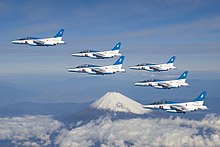Kawasaki T-4
| Kawasaki T-4 | |
|---|---|
 T-4 on display at Iwakuni in the United States |
|
| Type: | Jet trainer |
| Design country: | |
| Manufacturer: | |
| First flight: |
July 29, 1985 |
| Commissioning: |
20th September 1988 |
| Number of pieces: |
212 |
The Kawasaki T-4 is a twin-engine Japanese trainer aircraft .
history
At the end of the 1970s, there was a need for a successor to the Lockheed T-33 and Fuji T-1 training aircraft, which had been used in Japan until then . The used as supersonic trainer Mitsubishi T-2 came for reasons of cost out of the question and so and was on 4 September 1981, the two designs submitted Fuji FT-20 Kawasaki Ka-851 the latter selected as the new coach. The development of the machine, later designated as the T-4, began in 1981 and from 1983 funds were made available in the Japanese defense budget for the construction of a total of four prototypes, designated as XT-4, and two test cells. The machine was built as a joint production of Kawasaki as the main contractor (40%), Fuji (30% and responsible for the wings and nose of the fuselage) and Mitsubishi (30% and responsible for the center of the fuselage and stern). The construction of the first prototype (56-5601) began in 1984, the rollout took place in April 1985 at the Kawasaki plant in Gifu and on July 29, 1985 the first flight took place with Minoru Hanada and Toshimichi Tahara on board. The first production aircraft had its maiden flight on June 28, 1988 and in September of the same year the aircraft was introduced to training squadrons 31 and 32 of the Japanese Air Force ( JASDF ) in Hamamatsu . In 1989 the fleet was shut down for a short time because the engine blades had been deformed significantly. In 1993 the hundredth machine was delivered. The Japanese Air Force's aerobatic team, Blue Impulse , has been flying the T-4 since 1994 . By 2003 the number of machines produced rose to 208.
Military use
construction
The T-4 is a shoulder wing of aluminum , which at critical points with titanium is enhanced. The tandem cockpit, where the student pilot sits in front is with SHI-3J ejection seats , head-up displays equipped and various communication and navigation electronics. Two afterburnerless turbofan engines of the Ishikawajima-Harima type, each with 16 kN thrust, are used as propulsion systems . These are attached to the side of the fuselage, with the nozzles in front of the conventional tail unit pointing slightly outwards. The internal fuel capacity is 2240 liters in two tanks each in the fuselage and in the wings and can be supplemented by external additional tanks. The wings are swept by 27.5 ° and have a supercritical profile with a sawtooth leading edge . The elevators are designed as pendulum rudders . The hydraulically retractable three-point landing gear in a nose wheel arrangement is equipped with Bendix wheels. Various rockets, bombs, machine gun containers and additional tanks, but also equipment for electronic warfare , decoys or even target systems can be carried as armament at four external load stations under the wings and one under the fuselage . External luggage containers are also available for connecting flights with the aircraft, which are supplemented by a luggage compartment attached to the left in the fuselage and accessible from the outside.
Technical specifications
| Parameter | Kawasaki T-4 |
|---|---|
| Span: | 9.94 m |
| Length: | 13.00 m |
| Height: | 4.6 m |
| Wing area: | 21 m² |
| Empty weight: | 3,700 kg |
| Normal takeoff weight: | 5,640 kg |
| Maximum take-off weight: | 7,500 kg |
| Engine: | two Ishikawajima-Harima F3-IHI-30 turbofan engines with 16.37 kN each |
| Top speed: | Mach 0.9 (1038 km / h) |
| Marching speed: | 800 km / h |
| Rate of climb: | 50 m / s |
| Range: | 1,297 km |
| Action radius: | 800 km |
| Service ceiling: | 15,240 m |
| Take-off run: | 550 m |
| Landing runway: | 670 m |
| Crew: | two pilots |
